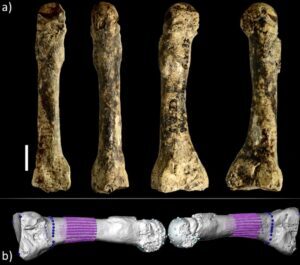
The presence and pattern of peopling of Europe during the Middle Pleistocene (between 770,000 and 126,000 years ago) has long been a subject of debate among scientists. Some scholars suggest coexistence of multiple human lineages during this time in Europe, and others propose a single lineage evolving from Homo heidelbergensis to Homo neanderthalensis. Recently, researchers conducted a morphometric, biomechanical and palaeopathological study of a second right metatarsal SdD2 hominin fossil found at the Sedia del Diavolo site in Italy, and found that the fossil showed features more archaic than those of Neanderthals. From the research, the study authors were also able to suggest a revised assessment of the technology and hunting strategies adopted by Homo in the region between MIS 9 (337,000 to 300,000 years ago) and MIS 8 (301,000 to 245,000 years ago).
“These observations,” state the authors in the published study*, “when interpreted within the context of the available fossil record, may suggest the co-existence of at least two hominin clades in the Italian Peninsula during the beginning of marine isotope stage (MIS) 8”.
Moreover, according to the study authors, the Sedia del Diavolo site provides evidence for the oldest association of a hominin, in this case possibly other than Neanderthal, and Levallois technology, challenging the previously held paradigm that only Neanderthals were associated with this technology in Europe. Finally, observance of bony stress injuries in the fossil specimen, coupled with the known prevalence of such bone stress injuries in specimens found within Early and Middle Pleistocene fossil assemblages, supports the contention for persistence hunting as a common activity among early members of Homo, the genus through which modern humans have evolved.
___________________________

(a) the SdD2 fossil, a second right metatarsal with a bony callus on the distal diaphysis, interpreted as a stress fracture38. From left to right: dorsal, plantar, lateral, and medial views. Reference scale bar 10 mm. (b) the set of landmarks (large spheres) and semilandmarks (small spheres) used for the three-dimensional geometric morphometric analysis of the proximal epiphysis (dark blue), distal epiphysis (light blue) and diaphysis (purple). CC BY-SA 4.0, Riga, A., Profico, A., Mori, T. et al. The Middle Pleistocene human metatarsal from Sedia del Diavolo (Rome, Italy). Sci Rep 14, 6024 (2024). https://doi.org/10.1038/s41598-024-55045-1
___________________________
*Riga, A., Profico, A., Mori, T. et al. The Middle Pleistocene human metatarsal from Sedia del Diavolo (Rome, Italy). Sci Rep 14, 6024 (2024). https://doi.org/10.1038/s41598-024-55045-1
___________________________


